IC434 NB, Pier 3
SII 7x300s, Ha 10x300s, OIII 4x300s. 8 darks, 18 flats each filter, 30 bias frames.
Calibration/integration/processing with Astro Pixel Processor v1.082. SCNR (green noise removal) in Siril, GIMP 2.10, NEAT Image for noise reduction.
First brush with narrowband, conclusion is more frames and longer exposures needed.
Dave
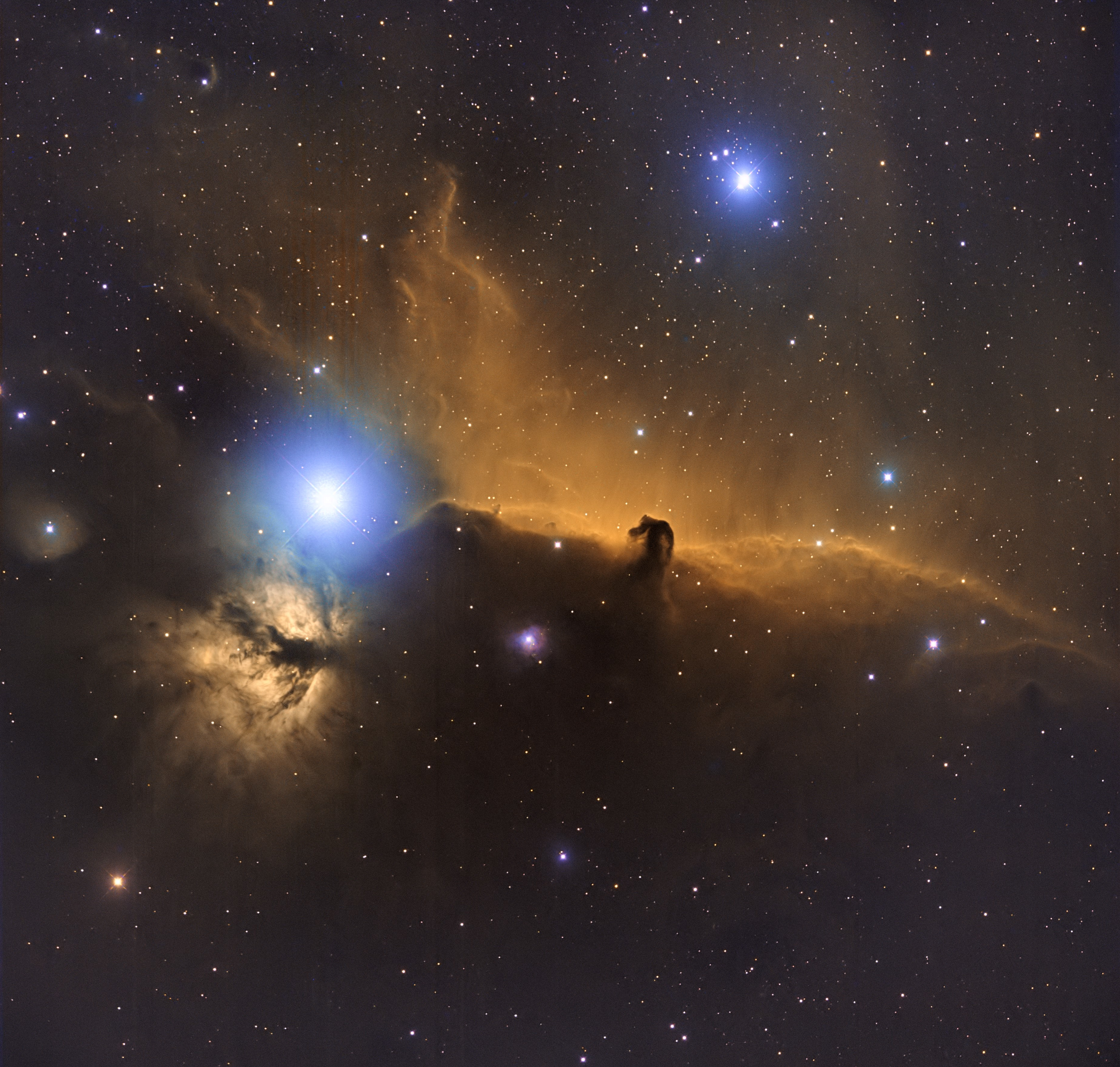
Calibration/integration/processing with Astro Pixel Processor v1.082. SCNR (green noise removal) in Siril, GIMP 2.10, NEAT Image for noise reduction.
First brush with narrowband, conclusion is more frames and longer exposures needed.
Dave
0
Hi Dave,
Really like the colour scheme, makes a welcome change. Certainly wouldn't have thought this was your first brush with narrowband. The detail in both ngc2023 and ngc2024 is very good, particularly the smaller ngc2023 which I think is exceptionally clear for such a small nebula. Great work. Thanks also for the information you provide, which is so useful to have.
I have had but only fairly recently the very occasional out of focus sub on that pier, so I wonder if that is why you only used 4 Olll Subs. Two hours = 10+7+7. Still a great image and I'm not sure those few extra frames would have made much difference.
Brian mentioned to me and I'm sure you don't mind him doing so during discussions on his app, that he's recommended to you longer subs. I tend to go for 600s but given what that would have meant in terms of the number of subs within 2 hours, I too would have gone for 300s just to have a reasonable number of them. For this target look like 300s is fine, useful to know.
Thanks for sharing Dave,
Cheers,
Ray
Really like the colour scheme, makes a welcome change. Certainly wouldn't have thought this was your first brush with narrowband. The detail in both ngc2023 and ngc2024 is very good, particularly the smaller ngc2023 which I think is exceptionally clear for such a small nebula. Great work. Thanks also for the information you provide, which is so useful to have.
I have had but only fairly recently the very occasional out of focus sub on that pier, so I wonder if that is why you only used 4 Olll Subs. Two hours = 10+7+7. Still a great image and I'm not sure those few extra frames would have made much difference.
Brian mentioned to me and I'm sure you don't mind him doing so during discussions on his app, that he's recommended to you longer subs. I tend to go for 600s but given what that would have meant in terms of the number of subs within 2 hours, I too would have gone for 300s just to have a reasonable number of them. For this target look like 300s is fine, useful to know.
Thanks for sharing Dave,
Cheers,
Ray
Ray
Roboscopes Guinea Pig
Thanks Ray.
I just renewed my Astro Pixel Processor renters license which mean I have a year's experience with the application now. Maybe that is starting to pay off. The capture was out of my hands so I can claim no credit for the image.
I captured 12x300s for each filter. I had to loose some frames with meteors. I reduced the OIII frames because I was getting swamped by blue. All very unscientific I know.
Brian analysed a sample frame of each type of filter in AstroImageJ - there is very little OIII signal at 300s.
I was inspired by this . Sarah knows what she is doing and always seems to use 1800s exposures for NB. I suppose I have applied my LRGB experience to NB but the reality (I guess) is that for NB 4x900s is going to give me far more than 12x300s. I will lay down the money and find out and hope there are no meteors about.
Dave
I just renewed my Astro Pixel Processor renters license which mean I have a year's experience with the application now. Maybe that is starting to pay off. The capture was out of my hands so I can claim no credit for the image.
I captured 12x300s for each filter. I had to loose some frames with meteors. I reduced the OIII frames because I was getting swamped by blue. All very unscientific I know.
Brian analysed a sample frame of each type of filter in AstroImageJ - there is very little OIII signal at 300s.
I was inspired by this . Sarah knows what she is doing and always seems to use 1800s exposures for NB. I suppose I have applied my LRGB experience to NB but the reality (I guess) is that for NB 4x900s is going to give me far more than 12x300s. I will lay down the money and find out and hope there are no meteors about.
Dave
Hi Dave,
Thanks for filling in all the gaps. So 3 hours in total.
As someone who occasionally does this, did you unintentionally keep citing meteors while knowing they were satellites. I assume they were satellites since they are more prevalent and I'd never recommend trying to capture meteor showers with a narrowband filter in place.
Just wondering what pixel rejection algorithm you used during integration to assist in excluding the satellite trails. I am a bit puzzled as it reads as if you were excluding frames containing them from the integration process.
Leading on from this personally I'd go for 600s subs unless you can afford to capture a reasonable number of 900s ones. Although 4 frames are sufficient there is a greater chance of satellite trails not being adequately removed during the integration process. I try for a minimum of 6 and ideally 8. Just my 1¢'s (sic) worth. No satellite trails then 900s every time.
No satellite trails then 900s every time.
Great image from Sara as usual and I see why you tried it out. By my extremely rough and ready estimation I reckon to obtain the same amount of signal you'd need at least 10 hours on that pier, however, you'll be almost doubling the resolution of that image. Brian would be the best person to calculate the equivalent integration times.
Hope you don't mind the suggestions.
Cheers,
Ray
Thanks for filling in all the gaps. So 3 hours in total.
As someone who occasionally does this, did you unintentionally keep citing meteors while knowing they were satellites. I assume they were satellites since they are more prevalent and I'd never recommend trying to capture meteor showers with a narrowband filter in place.
Just wondering what pixel rejection algorithm you used during integration to assist in excluding the satellite trails. I am a bit puzzled as it reads as if you were excluding frames containing them from the integration process.
Leading on from this personally I'd go for 600s subs unless you can afford to capture a reasonable number of 900s ones. Although 4 frames are sufficient there is a greater chance of satellite trails not being adequately removed during the integration process. I try for a minimum of 6 and ideally 8. Just my 1¢'s (sic) worth.
Great image from Sara as usual and I see why you tried it out. By my extremely rough and ready estimation I reckon to obtain the same amount of signal you'd need at least 10 hours on that pier, however, you'll be almost doubling the resolution of that image. Brian would be the best person to calculate the equivalent integration times.
Hope you don't mind the suggestions.
Cheers,
Ray
Ray
Roboscopes Guinea Pig
Hi Gents,
For sport, Dave and I urge CMOS users to experiment with longer exposures. Sometimes we are successful in changing minds. We use the example that a stack of 100x1s does not equal 1x100s. The reason is that the SNR of the 1s frame is so low that you are constantly trying to dig out of a hole. If possible I encourage people to settle for no less than SNR 5 per sub. Sometimes that is not achievable for various reasons.
With respect to IC434 and the cost of acquiring more SII, it is the same story. Compare these three scenarios while keeping in mind that the Stack SNR is equivalent:
100x300s = 30000s total integration time
32x600s = 19200s total integration time
17x900s = 15300s total integration time
So you see, graduating from 300s to 900s saves you half the cost! (These figures are for Pier 3)
Brian
For sport, Dave and I urge CMOS users to experiment with longer exposures. Sometimes we are successful in changing minds. We use the example that a stack of 100x1s does not equal 1x100s. The reason is that the SNR of the 1s frame is so low that you are constantly trying to dig out of a hole. If possible I encourage people to settle for no less than SNR 5 per sub. Sometimes that is not achievable for various reasons.
With respect to IC434 and the cost of acquiring more SII, it is the same story. Compare these three scenarios while keeping in mind that the Stack SNR is equivalent:
100x300s = 30000s total integration time
32x600s = 19200s total integration time
17x900s = 15300s total integration time
So you see, graduating from 300s to 900s saves you half the cost! (These figures are for Pier 3)
Brian
Ray
I think they were meteors - short trails rather than satellites which would have been trails across the frame. For pixel rejection I use APP on 'automatic' - on this object, APP logs report using Winsorized Clipping. I have 8 versions of processing this from using all frames down to rejection by eyeball.
The other thing I noticed is the wide variance on frame quality I have - must have been intermittent cloud at capture time. These are APP's qualtiy figures and the ranges I observed:
Brian calibrated & analysed a single Ha, SII and OIII frame in AstroImageJ - see image below. Ha looks OK, SII is weak and OIII is non-existent. The OIII could be down to too low an exposure or the object is not strong in OIII. Experimentation will resolve that.
With Brian's costing, 17 frames @ 900s will not break the bank. I just have to be sure I capture appropriate ratios so that the SNR is balanced across the 3 stacks.
Dave
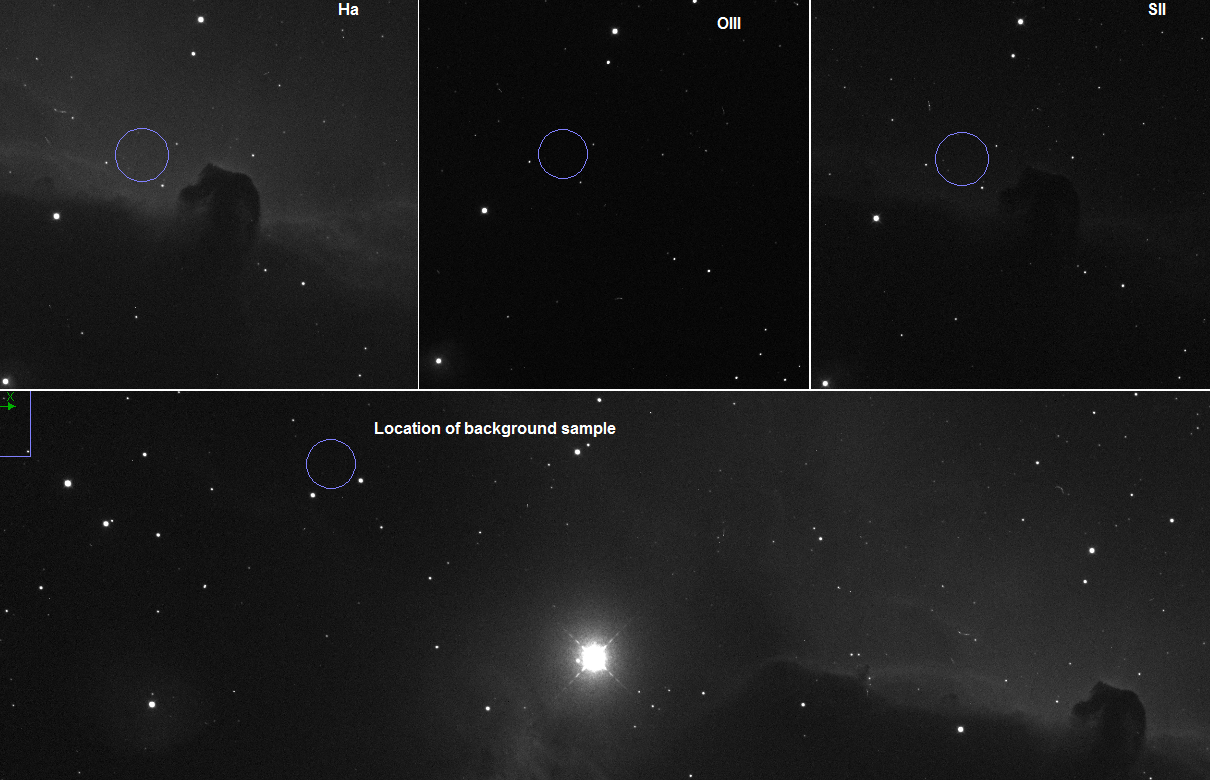
I think they were meteors - short trails rather than satellites which would have been trails across the frame. For pixel rejection I use APP on 'automatic' - on this object, APP logs report using Winsorized Clipping. I have 8 versions of processing this from using all frames down to rejection by eyeball.
The other thing I noticed is the wide variance on frame quality I have - must have been intermittent cloud at capture time. These are APP's qualtiy figures and the ranges I observed:
- Ha 3700 -> 1500[/*]SII 3100 -> 1200[/*]OIII 2630 -> 970[/*]
Brian calibrated & analysed a single Ha, SII and OIII frame in AstroImageJ - see image below. Ha looks OK, SII is weak and OIII is non-existent. The OIII could be down to too low an exposure or the object is not strong in OIII. Experimentation will resolve that.
With Brian's costing, 17 frames @ 900s will not break the bank. I just have to be sure I capture appropriate ratios so that the SNR is balanced across the 3 stacks.
Dave
Attachments (1)
Ray, Brian
Using this tool (thanks to Brian for the link) I have used the Ha, SII & OIII stacks (exported as JPG) to see what the various Ha/SII/OIII combinations can provide - images below for uploaded stacks, tri-colour output and bi-colour output. It becomes obvious that for my original SHO plan, the strong Ha makes the image have a strong green bias. My limited experience has taught me that this is best fixed at the data capture stage (requires learning pain) rather than torturing pixels for days in a PixelMangler application.
Dave
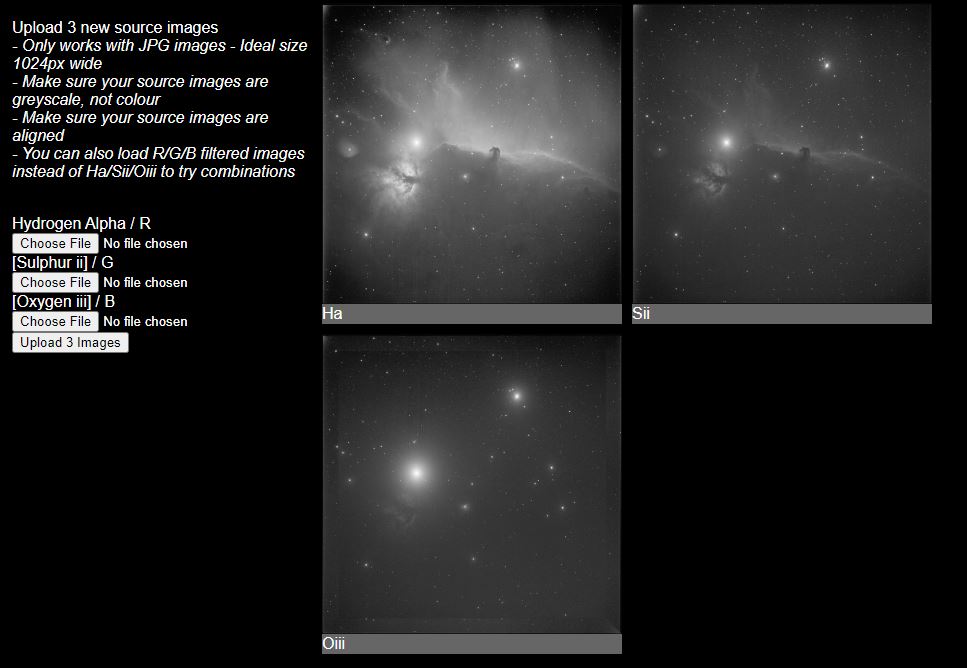
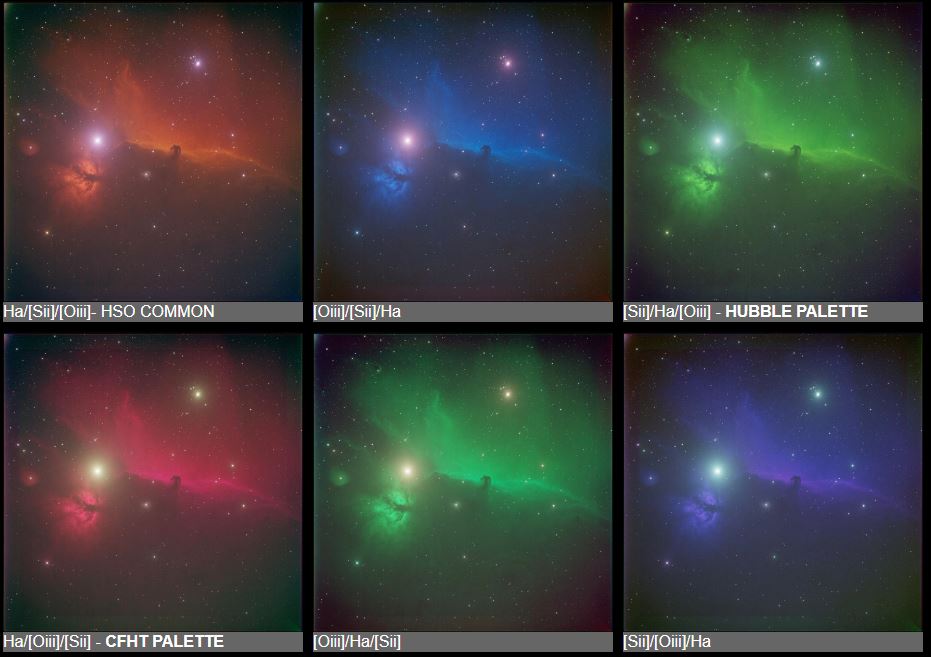
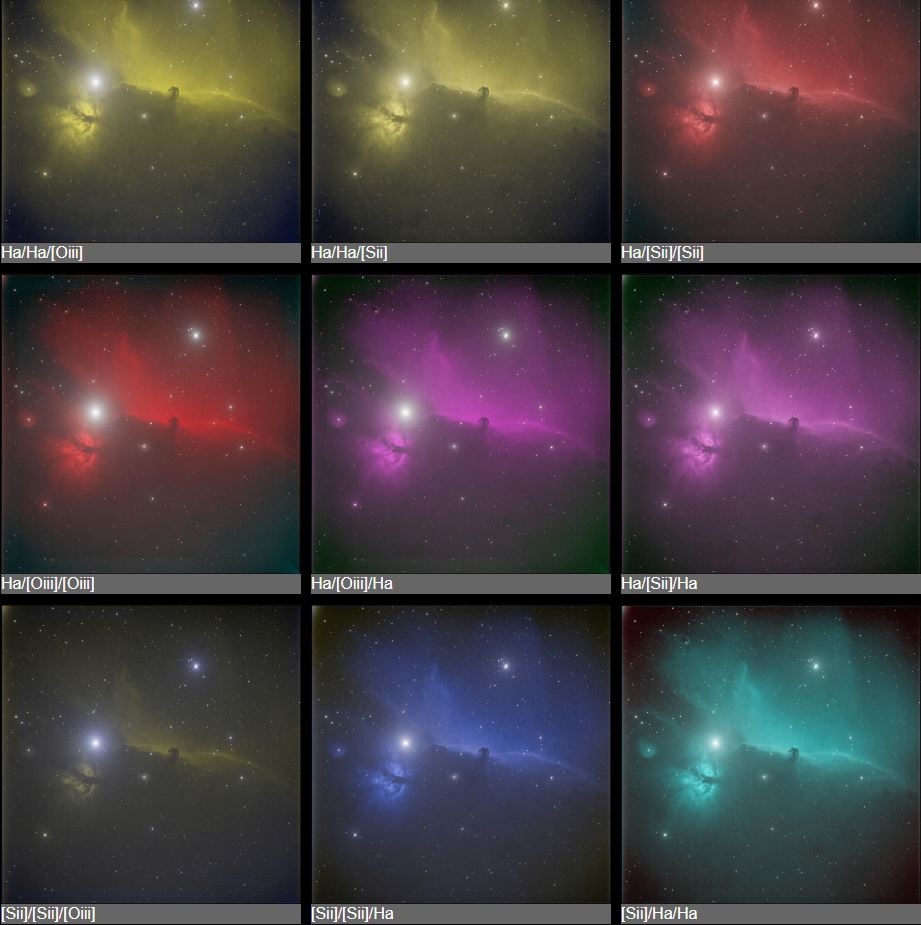
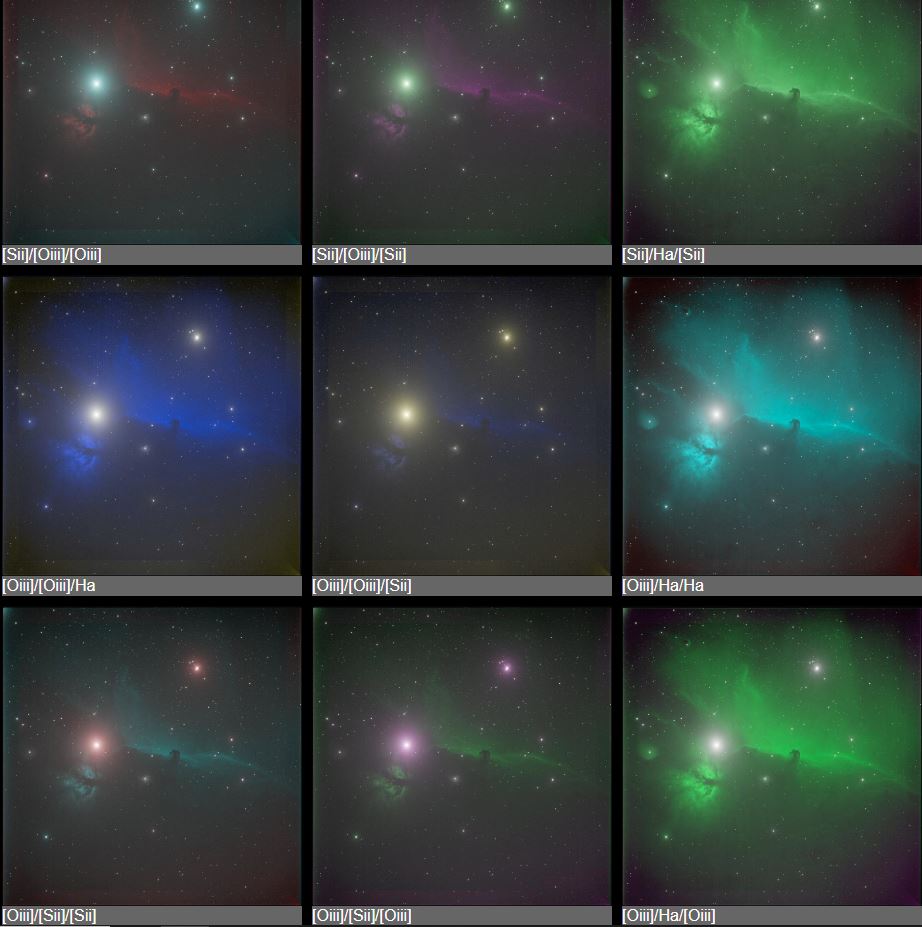
Using this tool (thanks to Brian for the link) I have used the Ha, SII & OIII stacks (exported as JPG) to see what the various Ha/SII/OIII combinations can provide - images below for uploaded stacks, tri-colour output and bi-colour output. It becomes obvious that for my original SHO plan, the strong Ha makes the image have a strong green bias. My limited experience has taught me that this is best fixed at the data capture stage (requires learning pain) rather than torturing pixels for days in a PixelMangler application.
Dave
Attachments (4)
Dave,
That is a neat tool. I suspect the reason why you aren't getting a lot of color variation in the nebula is due to the weakness of SII and OIII, and strength of Ha. More SII frames will solve that.
Your Ha stack consists of 10x300s which is SNR 22.9.
Your SII stack consists of 7x300s which is SNR 6.0.
I think you should keep your Ha stack, but for SII, replace the 7x300s with 17x900s.
Doing that will make the SNR of the SII stack and Ha stack equivalent at 22.6 and 22.9, respectively.
That requires 4.25 hours of telescope time. With the remaining 0.75 hours you may want to capture 3x900s of OIII simply to see if there is any trace of OIII. With luck there will be some so I can run my analysis on it to give you an estimate of how much more you need.
Brian
That is a neat tool. I suspect the reason why you aren't getting a lot of color variation in the nebula is due to the weakness of SII and OIII, and strength of Ha. More SII frames will solve that.
Your Ha stack consists of 10x300s which is SNR 22.9.
Your SII stack consists of 7x300s which is SNR 6.0.
I think you should keep your Ha stack, but for SII, replace the 7x300s with 17x900s.
Doing that will make the SNR of the SII stack and Ha stack equivalent at 22.6 and 22.9, respectively.
That requires 4.25 hours of telescope time. With the remaining 0.75 hours you may want to capture 3x900s of OIII simply to see if there is any trace of OIII. With luck there will be some so I can run my analysis on it to give you an estimate of how much more you need.
Brian
Thanks Brian and Dave,
What you have demonstrated explains a lot of what I have been experiencing, predominantly monochrome like images with, as Brian said, little colour variation. I now realise that the ratios of O3 and S2 to the Ha subs I have tended to use need to substantially increase in several of my images. Maybe then they'll more closely resemble those taken by others. Well colourways anyway.
Dave it's sod's law isn't it. Had you wanted to capture meteors and left a camera taking a succession of long exposures, you'd probably get just one in a single frame! Might it have been an annual shower at the time. The satellites that bug me most are those in geostationary orbits that will often blight several frames in a row trailing from one side of the image to the other. Noel Skum and his Starlink will very soon become the astrophotographers number one enemy though.
In the meantime clear skies to you both from an armchair astrophotographer who now never ever needs to go outside. Really great now it's winter in the northern hemisphere.
Cheers,
Ray
What you have demonstrated explains a lot of what I have been experiencing, predominantly monochrome like images with, as Brian said, little colour variation. I now realise that the ratios of O3 and S2 to the Ha subs I have tended to use need to substantially increase in several of my images. Maybe then they'll more closely resemble those taken by others. Well colourways anyway.
Dave it's sod's law isn't it. Had you wanted to capture meteors and left a camera taking a succession of long exposures, you'd probably get just one in a single frame! Might it have been an annual shower at the time. The satellites that bug me most are those in geostationary orbits that will often blight several frames in a row trailing from one side of the image to the other. Noel Skum and his Starlink will very soon become the astrophotographers number one enemy though.
In the meantime clear skies to you both from an armchair astrophotographer who now never ever needs to go outside. Really great now it's winter in the northern hemisphere.
Cheers,
Ray
Ray
Roboscopes Guinea Pig
- Page :
- 1
There are no replies made for this post yet.
Be one of the first to reply to this post!
Be one of the first to reply to this post!
This website uses cookies to manage authentication, navigation, and other functions. By using our website, you agree that we can place these types of cookies on your device.
You have declined cookies. This decision can be reversed.
Proud to use
-
FLI
-
656 Imaging
-
10 Micron
-
Planewave
-
ZWO
Resources
Company Details:
Roboscopes
802 Kingsbury Road
Birmingham
B24 9PS
United Kingdom




